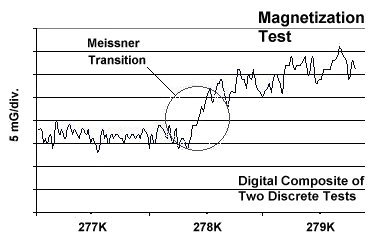

Superconductors.ORG herein announces the first observation of superconductivity above zero degrees Celsius. In repeated tests a small amount of the compound (Tl4Pb)Ba2MgCu8O16+ produced diamagnetic transitions over 277 Kelvin (see composite plot at page top) and resistive transitions over 276K (3C, 37F). This is the first time superconductivity has been seen above the freezing point of water. As such, once a refinement method is developed, this material could be successfully deployed in climates with year-round permafrost without any need for artificial cooling.
This milestone was achieved by substituting divalent lead (Pb II) into the barium (Ba) atomic sites that hole-dope the insulating layers of the 265K superconductor discovered in October 2010. Doping with Pb instead of Ba dampens lattice vibrations and further increases planar weight disparity along the C1 axis. Planar weight disparity has been found to be a key component of high temperature superconductivity. Since a minority phase also appeared near 271K magnetic, this makes the fourth and fifth world records that have resulted from a 9223 structure (shown below left).
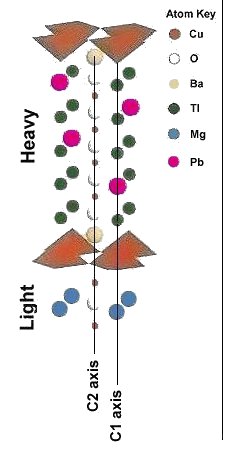
|
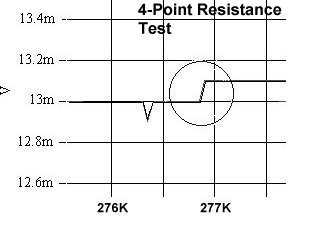 Resistance tests of this material were difficult due to the low bulk resistance of the pellet (around 5-15 ohms). Obtaining three significant bits of data resolution typically requires hundreds of ohms of resistance - or higher. Nonetheless, an unambiguous resistive transition appeared just below 277K (above), confirming the magnetization data as originating from superconductivity.
|
As mentioned, a minority phase near 271K magnetic (269K resistive)
also appeared in the test plots. This likely resulted from the Mg and Cu atoms trading places to alter the
stoichiometry from (Cu2Mg) to (CuMg2) in the "light" part of the structure. (Tl4Pb)-9223-Mg and (Tl4Pb)-9223-Mg2
are an analog to (Tl4Ba)-9223-Mg and (Tl4Ba)-9223-Mg2. See the below structure comparisons.
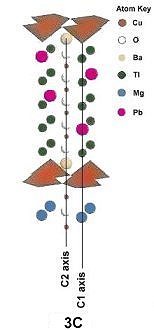
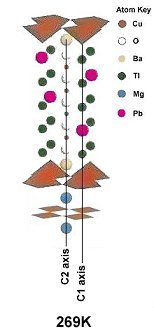

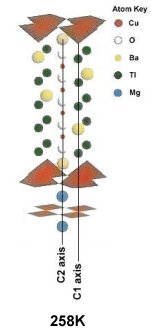
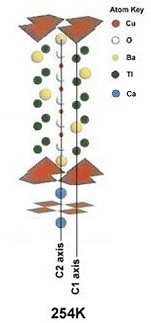
Dots have been placed within the C1 plot below, depicting where (Tl4Pb)-9223-Mg and (Tl4Pb)-9223-Mg2 lie relative to the other high performance thallium-cuprates. The location of the new dots is again consistent with the trend of the curves to roll over and flatten as we approach room temperature. (Temperatures plotted are resistive.)
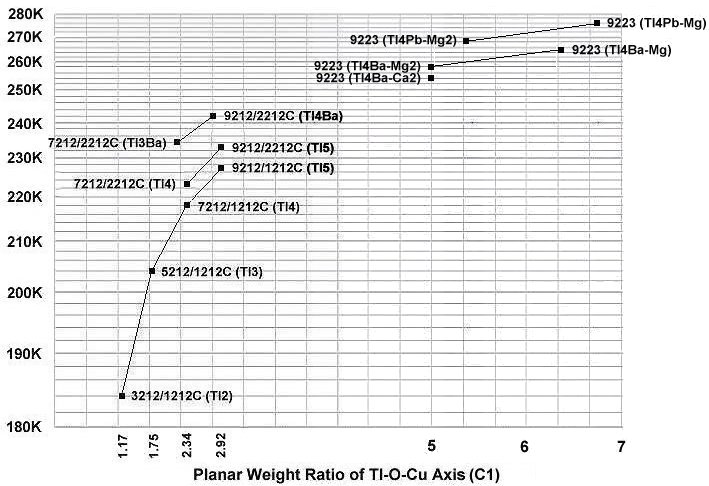
Like previous materials that required an asymmetrical C axis, synthesis was by the "layer cake" method (see below graphic). Since the ionic radius of magnesium is near that of copper, 0.72Å - v - 0.73Å, synthesizing this compound bulk would have placed magnesium into many of the blocking layer Cu sites. By using the layer cake method the desired 9223 structure is encouraged to form in the interference regions.

As with prior discoveries that are asymmetrical along the C axis, the volume fraction of (Tl4Pb)Ba2MgCu8O16+ is low (<1%). So commercialization will have to wait for a refinement method to be developed to increase the VF. As a result of a low VF, numerous R-T and magnetization tests may be necessary to see the respective transitions above the noise. This discovery is being released into the public domain without patent protection in order to encourage additional research. Synthesis was by the solid state reaction method.
The below stoichiometric ratios were used for the ODD layers:
PbO 99.99% (Alfa Aesar) 1.72 grains...and the below stoichiometric ratios for the EVEN layers.
MgO 99.95% (Alfa Aesar) 0.31 grainsThe chemical precursors were pelletized at 70,000 PSI and sintered for 35-36 hours at 865C. The pellet was then annealed for 10 hours at 500C in flowing O2. The magnetometer employed twin Honeywell SS94A1F Hall-effect sensors with a tandem sensitivity of 50 mv/gauss. The 4-point probe was bonded to the pellet with CW2400 silver epoxy and used 7 volts on the primary.
RESEARCH NOTE: The copper-oxides are strongly hygroscopic. All tests should be performed immediately after annealing.
E. Joe Eck
© 2010, 2011 Superconductors.ORG
All rights reserved.
 BACK to "News" page at Superconductors.ORG
BACK to "News" page at Superconductors.ORG